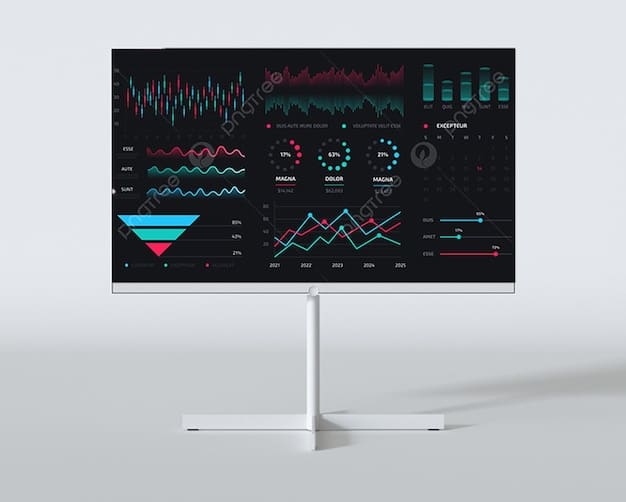NBA Salary Cap Projections for 2026: Impact on Player Contracts

The NBA Salary Cap Projections for 2026 significantly influence player contracts, team building strategies, and the league’s financial landscape by dictating maximum salaries and roster budgetary constraints for all 30 franchises.
The financial future of the National Basketball Association (NBA) is inextricably linked to its salary cap, a complex mechanism that balances competitive parity with player compensation. As we look ahead, the NBA Salary Cap Projections for 2026 loom large, poised to reshape the league’s economic landscape and, by extension, the very fabric of team rosters and player negotiations. Understanding these projections is not merely an exercise in financial forecasting; it’s a crucial insight into how teams will strategically build their rosters and how players will navigate their careers in the coming years.
Understanding the NBA Salary Cap Mechanism
The NBA’s salary cap is a fundamental component of its economic system, designed to foster competitive balance while allowing players to benefit from the league’s immense revenue. It’s not a hard cap, like in some other professional sports, but rather a “soft cap” that permits teams to exceed it under specific circumstances, usually involving re-signing their own players. This nuanced system creates a fascinating interplay between financial prudence and competitive ambition.
At its core, the salary cap is calculated as a percentage of the league’s Basketball Related Income (BRI), a comprehensive figure that includes everything from ticket sales and media rights to merchandise and sponsorship deals. The Collective Bargaining Agreement (CBA) between the NBA and the National Basketball Players Association (NBPA) dictates the exact percentage, which currently hovers around 49-51% of projected BRI. This direct link to league revenue means that as the NBA continues to grow and generate more income, the salary cap – and thus the financial capacity of teams – tends to increase.
Key Components of Salary Cap Calculation
Several factors weigh heavily in the annual determination of the salary cap. These elements, meticulously tracked and projected by league economists and team front offices, provide the bedrock for financial planning. Accurate forecasting of these components is vital for teams to make informed decisions regarding trades, free agency, and extensions.
The league office typically releases initial projections well in advance, followed by more precise figures closer to the start of the new league year. These projections are informed by a thorough analysis of current economic trends, pending media rights deals, and the overall health of the global sports market. A slight miscalculation by a team can have significant repercussions, potentially leading to financial inflexibility or missed opportunities in a highly competitive market.
- 🏀 Basketball Related Income (BRI): This is the most significant determinant. It encompasses all revenue streams, from broadcasting agreements to arena concessions. The growth of media rights, particularly, has been a massive driver of cap increases.
- 💰 Escrow Account: A percentage of player salaries is held in an escrow account to ensure a nearly 50/50 split of BRI between owners and players. Adjustments are made based on actual BRI at the end of the season.
- 📈 Minimum Salary Floor: There’s also a minimum team salary floor, usually 90% of the salary cap, that teams must spend. This prevents teams from deliberately underpaying players or hoarding cap space indefinitely without investing back into the product.
The Soft Cap and Its Exceptions
The term “soft cap” is crucial because it allows for a degree of flexibility that a hard cap would not. Teams can exceed the salary cap using various exceptions, which are designed to allow teams to retain their own talent or sign specific types of players. These exceptions are a fundamental part of team strategy, enabling competitive teams to stay together even as player salaries escalate.
Without these exceptions, it would be nearly impossible for successful teams to keep their core players together, as re-signing star players would almost certainly push them over a rigid cap. This flexibility adds a layer of strategic depth to team management, as general managers must skillfully navigate these rules to maximize their roster’s potential while staying fiscally responsible.
The Mid-Level Exception, for instance, allows teams over the cap to sign a player for a predetermined amount. The Bi-Annual Exception offers another route for acquiring talent, though it can only be used once every two years. Understanding the strategic application of these exceptions is vital for front offices looking to maximize their roster’s potential while operating within the league’s financial framework.
Drivers Behind the 2026 Salary Cap Projections
Projecting the NBA salary cap for 2026 involves scrutinizing several significant economic variables. The league’s financial health is a direct reflection of its popularity, global reach, and lucrative media partnerships. Anticipated shifts in these areas are the primary catalysts influencing future cap figures, creating a dynamic environment for player negotiations and team budgeting.
New Media Rights Deals
The current media rights deals are set to expire after the 2024-25 NBA season, paving the way for new agreements that are widely expected to be substantially more lucrative. These deals, encompassing domestic and international broadcasting, streaming, and digital rights, represent the largest single source of NBA revenue. Their negotiations are often fiercely competitive, with major media conglomerates vying for a piece of the highly coveted NBA product.

Industry analysts project that the next round of media rights could nearly double or even triple the annual revenue compared to the existing agreements. This substantial increase in Basketball Related Income (BRI) would naturally translate into a significant jump in the salary cap. The exact terms of these deals will be the most critical factor in determining the precise cap figure for 2026 and beyond.
The allure of live sports, particularly the NBA’s dynamic and globally resonant brand, makes these rights incredibly valuable. Increased fan engagement, the rise of new digital platforms, and the league’s expanding international footprint all contribute to the heightened demand and, consequently, the projected value of these upcoming contracts. The potential financial windfall from these deals is perhaps the most anticipated economic event for the NBA in the coming years.
League Growth and Global Expansion
Beyond media rights, the NBA’s continued growth, both domestically and internationally, plays a pivotal role in boosting BRI. The league’s strategic initiatives to expand its global footprint, particularly in markets like China, Europe, and Africa, contribute meaningfully to overall revenue. Popularity translates into higher merchandise sales, increased viewership, and expanded sponsorship opportunities.
The league has actively pursued international games, player development programs worldwide, and collaborations with global brands. These efforts not only broaden the fan base but also open new revenue streams. As the NBA brand becomes even more ingrained in global sports culture, the financial benefits accrue, pushing the salary cap upwards.
Furthermore, internal league growth, such as increased attendance, ticket prices, and successful new ventures like the NBA G-League and the Basketball Africa League, all add to the cumulative BRI. Each incremental increase in these areas contributes to a healthier financial outlook and higher future salary caps, creating a virtuous cycle of investment and growth.
Projected Salary Cap Numbers for 2026
While the precise figures for the 2026 NBA salary cap remain projections, early forecasts from league insiders and financial analysts offer a glimpse into what teams and players can expect. These numbers are subject to change based on the finalization of new media deals and overall economic conditions, but they provide a crucial framework for strategic planning.
Current estimates suggest a significant increase over prior seasons, driven predominantly by the imminent new media rights agreements. The impact of these agreements cannot be overstated, as they represent a generational leap in revenue for the league. This substantial injection of capital will directly translate into a more expansive financial environment for all 30 NBA franchises.
Official and Unofficial Projections
The NBA often provides initial range projections, and then refined figures as the new league year approaches. However, independent analysts and sports business reporters frequently offer their own insights based on market intelligence and financial modeling. These unofficial projections, while not definitive, can often shed light on the prevailing sentiment and potential outcomes.
For context, the salary cap for the 2023-24 season was set at $136 million, with projections for the 2024-25 season around $141 million. The leap to 2026 is expected to be more dramatic. While specific figures are still in flux, many anticipate the 2026 salary cap to fall within a range that could represent a sizable increase, potentially pushing well beyond the $150 million mark, and perhaps even approaching $170-180 million, depending on the final media deal valuations.
It’s important to remember that these are not set in stone. Economic shifts, unforeseen global events, or even changes in the NBA’s own financial strategy could influence the final number. However, the general consensus points towards a significant upward trend, creating a bullish outlook for player contracts and team spending capabilities.
Historical Cap Trends
Examining historical salary cap trends provides valuable context for understanding the 2026 projections. The cap has generally seen steady increases over the past few decades, punctuated by significant jumps following new media rights deals (e.g., the 2016-17 cap spike). This pattern suggests that the upcoming negotiations will similarly drive a notable surge.
The cap’s trajectory is tied to the league’s overall financial success. Periods of rapid growth or significant new revenue streams inevitably lead to higher cap figures, empowering teams with more spending power and players with higher earning potential. Conversely, economic downturns or periods of stagnation can lead to more modest increases or even flat figures, though the NBA has largely avoided significant declines.
The consistent upward movement reflects the NBA’s robust business model and increasing global appeal. As professional basketball continues to solidify its place as a top-tier global sport, the financial framework supporting it can be expected to expand accordingly, benefiting both the players and the league’s overall ecosystem.
Implications for Player Contracts
The projected increase in the 2026 NBA salary cap carries profound implications for player contracts across the league. It affects everything from maximum salary figures for star players to the depth of contracts offered to role players, fundamentally altering the economics of athlete compensation. Players and their agents are keenly aware of these projections, using them as leverage in negotiations to secure the most lucrative deals possible.
This cap hike presents a double-edged sword: while it offers unprecedented earning potential for players, it also forces teams to make increasingly difficult decisions about roster construction and fiscal responsibility. The balance between retaining homegrown talent and attracting external free agents becomes even more delicate as contract values soar.
Maximum Salary Contracts
Perhaps the most direct impact will be on maximum salary contracts. The maximum salary a player can earn is calculated as a percentage of the salary cap, varying based on their years of service in the league (0-6 years, 7-9 years, 10+ years). A higher cap automatically means higher maximum salaries, potentially leading to record-breaking deals for the league’s elite talent.
For example, a player with 10+ years of experience can sign for up to 35% of the salary cap. If the cap jumps from, say, $150 million to $170 million, that 35% translates into a substantial increase in annual earnings. This will undoubtedly lead to a new wave of supermax contract extensions for deserving star players, ensuring they remain with their current teams.
Teams will need to carefully consider these increased max figures when planning their long-term financial commitments. While securing a cornerstone player is paramount, the larger max contracts mean less cap flexibility for filling out the rest of the roster, placing a premium on smart drafting and shrewd mid-level signings.
Mid-Level and Minimum Contracts
The impact isn’t limited to the top earners. Mid-level contracts, which are crucial for teams to sign quality role players when over the cap, will also see a bump. These exceptions are typically tied proportionally to the cap, meaning a rising tide lifts all boats, to a certain extent. This allows teams to offer more competitive deals to veterans and valuable complementary pieces.

Similarly, minimum contracts, which define the floor for player salaries based on years of experience, will also slightly increase. While these are smaller increments, they collectively contribute to a healthier financial landscape for players across the entire spectrum of the league, ensuring even those at the margins benefit from the league’s growing prosperity.
However, increased minimums and mid-level exceptions also mean a higher payroll floor for all teams, regardless of their competitive standing. This reinforces the need for astute financial management and strategic drafting, as every dollar spent or saved carries more weight in a landscape of escalating costs.
Impact on Team Building and Strategy
The significant projected increase in the NBA salary cap for 2026 will profoundly influence how teams approach roster construction, player acquisitions, and long-term financial planning. General Managers and team executives are already calibrating their strategies to adapt to this evolving financial reality, seeking to maximize competitive advantage.
The shift in cap space could lead to more aggressive spending by teams with available funds, or, conversely, a focus on internal development and retention for teams already committed to high-salaried players. The choices made in the next few years will shape the competitive balance of the league for years to come.
Free Agency and Trade Market
A higher salary cap typically injects more money into the free agency market. Teams with cap space will have more flexibility to offer higher annual salaries and longer contracts, potentially creating a more competitive bidding environment for sought-after free agents. This could see a resurgence of aggressive spending after a period of relative caution by some teams.
On the trade market, the dynamics will also shift. Higher salaries on existing contracts mean that matching salaries in trades becomes more complex, especially for teams looking to unload large deals. However, for teams looking to take on significant salary, the increased cap provides more headroom to do so, potentially facilitating blockbuster trades that otherwise might have been fiscally impossible.
Teams will need to carefully assess whether to prioritize cap space for star free agents or allocate resources to retain their own talent through extensions. The availability of higher max contracts makes it easier for teams to lock up their foundational players, but it also means those players consume a larger portion of the overall cap.
Drafting and Player Development
With higher max contracts potentially limiting flexibility for acquiring external talent, the importance of drafting and player development becomes even more pronounced. Teams that can consistently develop their draft picks into contributors or even stars will gain a tremendous competitive advantage, as rookie-scale contracts offer immense value relative to their on-court production for several years.
Investing in state-of-the-art training facilities, advanced analytics departments, and robust development programs will be more critical than ever. Identifying and nurturing talent from within allows teams to build sustainable success without constantly chasing high-priced free agents, who may present greater financial risks.
This emphasis on internal growth also extends to identifying overlooked talent in the G-League or international leagues, providing cost-effective avenues to build a deep and versatile roster. A strong player development pipeline is no longer just a luxury; it’s a strategic imperative for long-term health and competitiveness in a high-cap environment.
Potential Challenges and Considerations
While a rising salary cap generally signals a prosperous league, it also introduces several challenges and considerations for both teams and the NBA as a whole. Navigating these complexities will require careful financial planning, strategic foresight, and a disciplined approach to roster management.
The increased financial power can lead to heightened expectations and pressure on teams, while also potentially widening the gap between large-market and small-market franchises, despite mechanisms designed to prevent such disparity.
Luxury Tax Implications
The luxury tax threshold, which penalizes teams for exceeding the cap by a certain margin, will also rise in proportion to the salary cap. While this provides more headroom for spending, the repeater tax (which imposes harsher penalties on teams that are common luxury tax payers) remains a significant deterrent. Teams will have to weigh the desire to build a championship contender against the escalating costs of luxury tax payments.
For example, exceeding the luxury tax by $10 million could cost a team $25 million in tax payments for a first-time offender, but significantly more for a repeater. This punitive structure encourages teams to manage their payrolls efficiently, even with a higher cap. Teams that consistently pay the tax must have justifiable on-court success to appease ownership and fans.
The luxury tax system is a critical component of the NBA’s competitive balance efforts, ensuring that even teams with deep pockets face financial consequences for overspending. It forces strategic decisions about which players are truly worth the escalating costs, especially when factoring in the compounded penalties for habitual tax payers.
Competitive Balance
A substantial cap increase could, paradoxically, place additional stress on competitive balance if not managed carefully. Teams that project to have significant cap space in 2026 might aggressively pursue high-profile free agents, potentially concentrating top talent in a few desirable markets. This could lead to an even greater disparity between contenders and rebuilding teams.
However, the NBA and NBPA have historically adjusted the CBA to counteract such trends, often through mechanisms like the repeater tax or stricter rules around sign-and-trades. The goal is always to prevent a few superteams from dominating the league year after year, which can diminish interest and competition.
Furthermore, a higher cap also means more financial resources available for all teams, theoretically allowing even smaller market teams to offer competitive contracts. The key will be how these teams leverage their newfound spending power and whether they can attract and retain top-tier talent in an increasingly expensive market.
| Key Point | Brief Description |
|---|---|
| 📊 Cap Projections | Expected to significantly increase due to new media rights deals, potentially reaching $170M+. |
| 💵 Player Contracts | Max salaries will rise, impacting deals for star players and overall player compensation. |
| 🏀 Team Building | Teams will face new strategic decisions for free agency, trades, and internal player development. |
| ⚖️ Challenges | Luxury tax implications and maintaining competitive balance are key considerations. |
Frequently Asked Questions About NBA Salary Cap Projections
▼
The most significant driver is the new media rights deals set to be finalized after the 2024-25 season. These agreements, covering broadcasting, streaming, and digital rights, are projected to substantially increase the league’s Basketball Related Income (BRI), directly translating to a higher salary cap for all teams.
▼
Maximum player contracts are calculated as a percentage of the salary cap, varying by years of experience. A higher salary cap automatically means an increase in the maximum annual salary a player can earn, potentially leading to new record deals for the league’s top-tier talent and significantly impacting contract negotiations.
▼
While the luxury tax threshold will also increase alongside the salary cap, teams with high payrolls may still find it challenging to avoid the tax, especially if they are repeat offenders. The luxury tax system is designed to penalize excessive spending, forcing teams to make strategic financial decisions even with more cap space.
▼
A higher cap provides more financial flexibility for all teams, including those in smaller markets, to offer competitive contracts. However, the importance of drafting well and developing internal talent will be even more critical for these teams to build sustainable rosters without relying solely on large free agency splashes.
▼
The 2026 salary cap projections are not yet finalized. While strong indications point to a significant increase, the exact figures will depend on the finalization of new media rights deals, overall economic conditions, and the specific terms of the Collective Bargaining Agreement (CBA). Official figures are typically released closer to the start of the new league year.
Conclusion
The NBA Salary Cap Projections for 2026 are more than mere numbers; they are a clear indicator of the league’s robust financial health and a powerful catalyst for significant shifts in player contracts and team strategies. Driven primarily by anticipated lucrative media rights deals, the projected increase will redefine the financial landscape of professional basketball, offering unprecedented earning potential for players and presenting both opportunities and challenges for team management. Ultimately, navigating this evolving economic environment with foresight and strategic acumen will be paramount for competitive success in the coming years.





